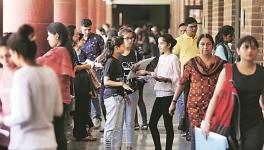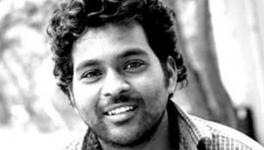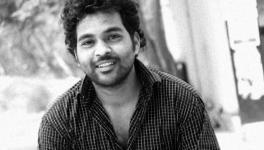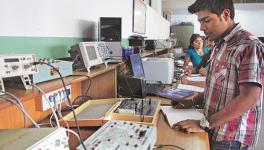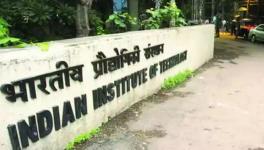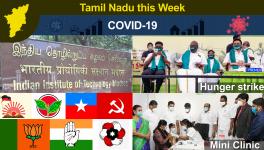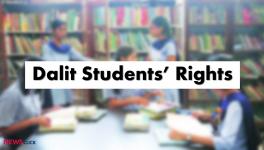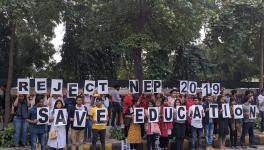Centre-Appointed Panel’s Proposal to Exempt IITs From Reservation in Faculty Posts is Faulty
In a report submitted to the Government of India earlier this year, a committee constituted to propose measures towards more effectively implementing the policy of reservations in the country’s 23 IITs has suggested that reservations in faculty appointments be done away with.
Citing a lack in adequately qualified candidates from marginalised communities and the need to maintain “academic excellence”, the report notes that, “Being established and recognised as institutions of national importance under an Act of Parliament, IITs have ought to be listed under (clause 4) of the CEI (Reservation in Teacher’s Cadre) Act 2019, for exemption from reservations.” Doing so would add the IITs to the list of eight institutions considered “Institutions of Excellence” that are exempted from the application of reservation provisions.
The caste system and the bogey of “merit” have long been used, both morally and legally, as an instrument to justify the privileges in opportunities and socio-economic outcomes for those from dominant caste groups. That the proportion of students from Scheduled Caste, Scheduled Tribe, and Other Backward Classes households in streams such as engineering are low due to systemic design rather than any disproportionate allocation of “merit” to candidates from dominant caste households may be demonstrated by how the great engineers and architects of medieval and ancient India came from marginalised castes.
The machinations of the same are starkly evident when one views India’s education sector in its entirety — particularly its Higher Education Institutions — long accused of being spaces that intrinsically perpetuate the systemic exclusion of certain communities from accessing the means to a more dignified life.
The All India Survey on Higher Education 2018-19 shows that the enrolment of SC and ST students in higher education is 14.9% and 5.5% respectively. The Gross Enrolment Ratio (GER) for SC and ST students in higher education is 23% and 17.2% respectively, less than the national average of 26.3%. The composition of the teaching community in this regard presents a graver picture. Those from the general categories make up 56.7% of all teaching appointments, with SCs and STs accounting for only 8.8% and 2.36% of the same respectively. Even among the non-teaching staff, those from the general category occupy 54.7% of all posts.
While, the committee constituted to make the reservations policy at the IITs more effective justified their proposed measures to do away with reservations in faculty appointments by citing a lack of adequately-qualified candidates from reserved categories, a cursory perusal of publicly available data (Figure 1) may evidence this as an effort towards misrepresenting the extent to which Higher Education Institutions, in general, and the IITs, in particular, are already undermining constitutionally mandated reservation provisions.
Upon studying the category-wise admissions to doctoral programmes at the IITs (graduates of which the IITs would most likely consider for faculty positions), one would make the following observations: as opposed to the provision of 15% reservation for SC students, only an average of 9.07% have been admitted between 2015 and 2019, reaching a high of 9.21% in 2015 and dropping to 8.77% in 2017. The situation for SC students was the most alarming at IIT Gandhinagar, with only 4.54% SC candidates being admitted on average between 2015 and 2019 to the institute’s PhD programme.
The figure for ST students presents an even more distressing scenario, with ST students comprising on average only around 2.09% of the total PhD candidates admitted every year over the same time period. The percentage of ST students admitted in 2018 was the lowest in this regard, constituting only 1.84% of all new admits to the PhD programme at the IITs that year, as opposed to the mandated provision of 7.5%. Although marginally better, the situation for OBC students is still worrying, with them making up 23.23% on average of all admitted PhD candidates between 2015 and 2019.
Category-wise admission of SC, ST, and OBC students to PhD programmes in the IITs, 2015-19
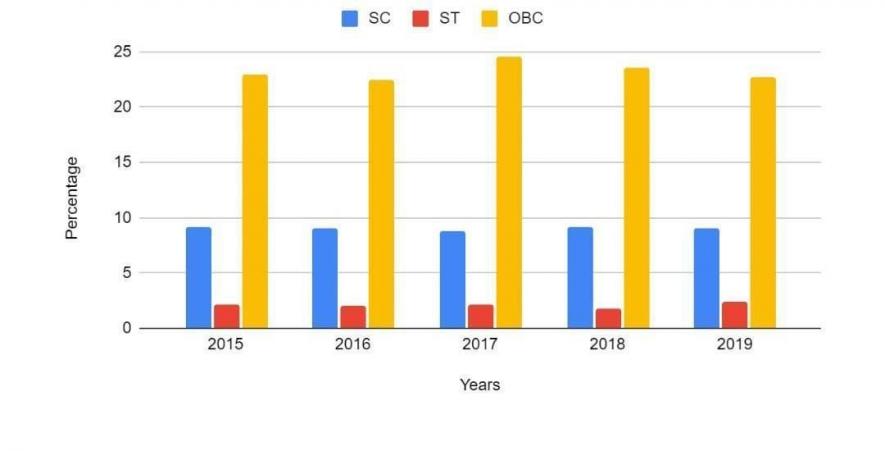
(Source: Unstarred Question No. 1681 answered in Rajya Sabha on 05/03/2020)
The above, however, is still an incomplete representation of the institutionalisation of discrimination within the ivory towers that are India’s Higher Educational Institutions. As noted in a recent study, SC and ST households in India annually earn an income 0.8 times and 0.7 times lower than the all-India average income of Rs. 1,13,222. While dominant caste (non-Brahmin) households typically earn an annual income of Rs. 1,64,633 and Brahmin households earn an annual income of Rs. 1,67,013, the average SC household in India earns an annual income of Rs. 89,356, whereas the average ST household earns an annual income of Rs. 75,216.
The study shows a similar trend with respect to asset ownership, with SC and ST households owning on an average only 0.69 times and 0.56 times the assets owned by a Brahmin household. This is further reiterated by the NFHS-3 data which concludes that while 53.27% of all SCs may be categorised as either “Poorest” or “Poorer” on the Wealth Index, the same for all Dominant Castes is only 8.36% on average. The NFHS-4 has similarly gone on to note how 50% of SC households and 71% of ST households fall in the two lowest wealth quintiles.
A study analysing data from the 71st Round of the National Sample Survey similarly illustrates that when compared to their overall representation in India’s population (19%), only 10.4% of all owners of businesses or Chief Executives are from SC communities. The proportion of dominant castes, however, for the same is 42.3% when their overall share in India’s population is 28.8%.
This trend intensifies if one considers the social locations of those who find employment as managers, elected representatives, professionals, or professors. While only 10.1% of those in the above category are from SC households, the figure for those from dominant caste households is over 51%. However, India’s SC citizenry is overrepresented in forestry, fishing, hunting, and as agricultural workers, where they constitute nearly 33% of all those who are employed. The proportion of dominant castes in the above occupations, however, is only 12.7%. The above necessarily has implications in terms of the social locations of students who can even begin to aspire to attain higher education in India.
Also see: 'IITs, IIMs and Central Universities Dominated by Upper Castes'
As compared to 19.63% of all 15-17-year-old children from dominant caste households who either drop out or never enrol in secondary education, the figure for children from SC communities is 33.3%. The figure nearly doubles for children from ST households, with 37.54% of all ST children either dropping out or never enrolling in secondary education. The institutionalised inaccessibility of higher education for marginalised caste groups is brought into perspective when one notes how the figure of dropouts increases to 70.61% for SC children in the 18-21 age group as compared to 50.1% for those from dominant castes. The interplay herein between caste and class is to be further noted in light of how dropout rates across social locations drop drastically as one moves up each Monthly Per Capita Expenditure (MPCE) quartile.
Discrimination Within Institutions
While students from marginalised castes are undeniably under-represented in higher education, it is also evident that those who do manage to access such spaces face extant structural discrimination with an abject lack of mechanisms for grievance redressal. The Sukhdeo Thorat Committee, formed after multiple instances of discrimination against marginalised students at AIIMS Delhi in 2006, detailed patently discriminatory practices in the institution, with 72% of SC and ST students reporting facing discrimination by faculty members during teaching sessions.
A report of the National Commission for Scheduled Castes also highlighted identity-based discrimination, the ghettoisation of students from marginalised communities in hostels, scuttling of constitutionally mandated reservation provisions, and denial of positions to qualified members of the faculty hailing from marginalised communities at the institution.
Multiple judicial rulings, committees, and statutory authorities have attempted to address the issue of discrimination in spaces of higher education. However, most of their recommendations remain only on paper.
The Thorat Committee recommended the constitution of an “Equal Opportunity Office” at AIIMS Delhi for the independent and unbiased redressal of grievances of students from marginalised communities. These recommendations, however, were rejected by the AIIMS Delhi Administration.
In July 2013, the High Court of Andhra Pradesh, taking cognisance of the suicides of Dalit and Adivasi students from universities in Hyderabad, recommended that, “All committees constituted by universities should have external members from the SC, ST, OBC and other minority communities.” The Court also recommended that, “All Universities should have preparatory courses, bridge courses, including peer learning mechanisms, to support SC/ST, OBC and other minority students, first-generation learners and economically backward students.”
A study on the status of the implementation of Equal Opportunity Cell guidelines in the IITs, IIMs, NITs, among others, is particularly illustrative. Of the 132 such institutes that were surveyed, the websites of only 42 institutions were found to contain any information that would enable one to either access the Equal Opportunity Cell or to even lodge a complaint.
The above exemplifies how, rather than doing away with reservations on the whole in India’s educational spaces, there is an urgent need instead to strengthen the implementation of constitutionally mandated reservation provisions. The recommendations made by the Committee in question stem from the structures of oppression that operate in society, wherein those who are in positions of decision-making across institutions in contemporary India are overwhelmingly from dominant caste households. Rather than attempting to reduce the already disproportionately low number of teaching faculty from marginalised caste backgrounds, the Committee would have done well to instead recommend steps towards making academia more accessible and inclusive.
The writer is a research associate at the Social and Political Research Foundation. The views are personal.
Get the latest reports & analysis with people's perspective on Protests, movements & deep analytical videos, discussions of the current affairs in your Telegram app. Subscribe to NewsClick's Telegram channel & get Real-Time updates on stories, as they get published on our website.









